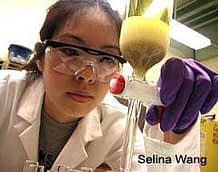A new study by the UC Davis Olive Center under the direction of the California Olive Oil Council (COOC) illustrates the chemical diversity of oils made from the most common olive varieties grown in the United States.
Funded under the USDA’s Technical Assistance for Specialty Crops (TASC) grant, the research is the second phase of an earlier study and part of an ongoing initiative to establish the chemical profiles of domestic olive oils, in order to evaluate and fine-tune U.S. standards and prevent trade restrictions for American olive oil exporters.
The technical standards for olive oil established by the International Olive Council (IOC) are based on the chemical profiles of European and North African olive oils. The unique chemical characteristics of New World olive oils can exceed certain limits in the international standards, causing a downgrade and closing off potential markets to American producers.
Ninety percent of the global olive oil consumption is beyond American shores.
In this study, which was designed by UC Davis Olive Center Research Director Selina Wang, 60 domestic monovarietal extra virgin olive oils from the 2010 harvest were collected directly from producers from February through April, 2011 and put through a battery of tests at labs in the U.S and Australia.
Specifically, testing was carried out by the UC Davis Olive Center, the Blakely Laboratory, the Australian Oils Research Laboratory (AORL) and the COOC taste panel.
 Ten of the samples (around 17 percent) were found to have sensory defects and would therefore not be considered to be extra virgin on that basis alone.
Ten of the samples (around 17 percent) were found to have sensory defects and would therefore not be considered to be extra virgin on that basis alone.
All 60 samples passed the test for free fatty acids (FFA) with levels below the 0.8 percent limit in both the USDA and IOC standards.
Several oils tested were found to have campesterol levels too high for the extra virgin grade according to the IOC standards, which sets the limit at 4.0 percent, but only one of the 60 samples exceeded (and just barely) the campesterol limit of 4.5 percent set in the 2010 USDA Standards for Olive Oil and Olive Pomace Oil.
And while 10 samples failed taste tests, 4 failed the chemical quality tests (acidity, peroxide and UV) and 16 failed purity tests (FAP, sterols, wax and ECN 42), not one of the samples failed the PPP and DAG limits adopted by the Australian Olive Association, raising questions, the researchers said, about what the limits should be if they are going to be considered part of the U.S. picture. The PPP and DAG results suggested that all of the olive oils tested were reasonably fresh.
Although the size of the survey was limited and focused on monovarietals, the results amounted to less than a perfect report card for the samples that were analyzed, with more than 25 percent falling short of extra virgin quality.
One sample failed a “wax” test suggesting it had likely been extracted from leftover pomace. That sample also failed a number of other tests including the sensory panels. Dr. Wang declined to disclose the brand, noting that producers supplied survey samples with the understanding that the brand name would be kept confidential.
Looking forward, the report calls for a “streamlining” of the methods used to measure olive oil quality, such as the PPP and DAG tests, and a better understanding of how those tests, and storage time, impact the initial quality indicators like acidity.
With wording reminiscent of the recent Australian Olive Association conference and repeated lately in Napa, Dixon and Sacramento, the report closes with the prediction that, with a little more work, the “life” of an olive oil can be established and new tools will enable olive oil buyers to make more informed decisions.
See Also:Composite Chemical Picture of US Olive Oil (UC Davis Olive Center





